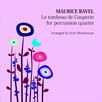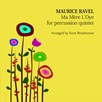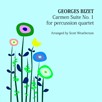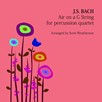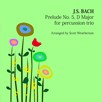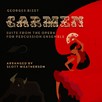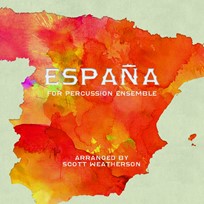
España
Composer: Emmanuel Chabrier
Instrument: Percussion Ensemble
Level: Intermediate
Published: 2015
Price: €35.00
Item details
-
Description +
-
Arranged by Scott Weatherson
Duration: 7 min.
Emmanuel Chabrier's España (1883) (subtitled Rapsodie pour orchestre), was written after the composers travels in Spain in the previous year, and was the first in a line of Spanish-flavoured orchestral music, with fellow French composers Debussy and Ravel also writing works which evoked the colours and folk melodies of the Iberian peninsula. Chabrier's influence extended outside his own country; Stravinksy incorporated elements of España in parts of Petrushka.
This arrangement is written for eight percussionists – glockenspiel, xylophone, 2 vibraphones, 3 marimbas (including one 5 octave instrument) and tambourine, with all keyboard percussion parts using two mallet playing only. As with many works, the piece started life as a piano duet, and the rhythmic writing and energetic style it contains is well suited to the instruments of the percussion ensemble.
-
-
Instrumentation +
-
Percussion Ensemble (8 players)
Required Instruments:
1 Glockenspiel
1 Xylophone
2 Vibraphones
3 Marimbas (including one 5 octave instrument)
1 Tambourine
-
-
Watch+
-
About the composer +
-
Alexis Emmanuel Chabrier (January 18, 1841 – September 13, 1894) was a French Romantic composer and pianist. Although known primarily for two of his orchestral works, España and Joyeuse marche, he left an important corpus of operas (including L'étoile), songs, and piano music. He was admired by composers as diverse as Debussy, Ravel, Richard Strauss, Satie, Schmitt, Stravinsky, and the group of composers known as Les six. Stravinsky alluded to España in his ballet Petrushka; Gustav Mahler called España "the beginnings of modern music" and alluded to the "Dance Villageoise" in the Rondo Burleske movement of his Ninth Symphony. Ravel wrote that the opening bars of Le roi malgré lui changed the course of harmony in France, Poulenc wrote a biography of the composer, and Richard Strauss conducted the first staged performance of Chabrier's incomplete opera Briséïs.
Chabrier was also associated with some of the leading writers and painters of his time. He was especially friendly with the painters Claude Monet and Édouard Manet, and collected Impressionist paintings before Impressionism became fashionable. A number of such paintings from his personal collection are now housed in some of the world's leading art museums.
-
-
Reviews +
-
Review (Percussive Notes, July 2016)
“España,” originally an orchestral score composed in 1883 by Emmaunel Chabrier, is written in an allegro con fuoco 3/8 with a familiar Spanish-style flare that includes bouncy melodies and driving polyrhythms. In this arrangement, featuring seven keyboard percussion instruments and one tambourine, Weatherson artfully matches the breadth of colors found in the orchestra to the more limited capacity of a primarily keyboard percussion ensemble.
The piece requires only two-mallet proficiency from all keyboard percussionists; however, some mallet parts are more challenging than others. The keyboard percussionists execute quick running lines, flashy embellishments, staccato accompaniment figures, and punchy bass lines. The tambourine part, almost an exact replica from the original score, hints at the “bolero” rhythm throughout the piece, only laying it down for a lengthy period during rehearsal letters B and R. “España” is a very fun piece to listen to and to play, and would make a great addition to any ensemble program.
—Julie Licata
-
-
Credits +
-
Front Cover Graphics and Layout: Gaia Gomes
Engraving: Scott Weatherson & CPH Engraving
Printed in Copenhagen, Denmark
Copyright © Edition Svitzer
www.editionsvitzer.com
-

